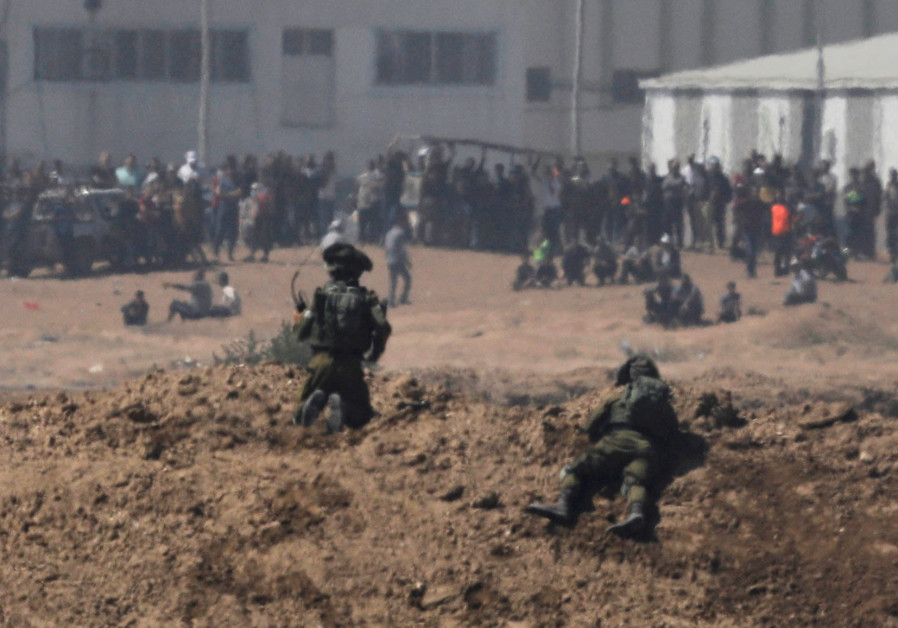View from the Gaza front: Is the IDF acting legally?

Israeli soldiers, on the Israeli side of the border with the Gaza Strip, watch Palestinian protesters in Gaza May 14, 2018. (photo credit: REUTERS/AMIR COHEN)
Is the IDF acting legally and with restraint or illegally and with loose open fire rules as the Gaza border confrontation continues? Is the confrontation about nonviolent protests or violent riots?
Whatever is going on at the Gaza border, reportedly 58 Palestinians had been killed there (who are civilians and who are not, will surely be debated), more than the number that have been killed cumulatively in the weekly confrontations over the last 6 weeks.
This, after the government recently told the High Court of Justice on May 1 that it had revised its open fire rules over the course of the confrontations. This was also after The Jerusalem Post had been told recently that the IDF was exercising greater restraint in its use of live fire.
When it comes to trying to unwind all of the confusing questions surrounding the Gaza border crisis, it is one thing to run through the talking points of the Israeli and the Palestinian side, it’s another thing to watch the confrontation up close.
From watching the confrontation up close near Nahal Oz on Monday (granted only from the Israeli side), there are a few important observations.
As the protests started, remained relatively calm and less spread out, there was less smoke, fewer signs of Palestinian explosives, fewer sounds of Israeli gunfire, fewer Palestinian fire kites and no Israeli air strikes or tank fire to speak of.
At a particular moment, it appeared that the Palestinian crowds were given an order or a signal.
Tension on the Israel-Gaza border as the US embassy is moved to Jerusalem, May 14, 2018 (IDF Spokesperson’s Unit)
Suddenly, thousands of them started sprinting and streaming along the border. Shortly thereafter, the number of large plumes of smoke – from burning tires, Molotov cocktails or other explosives – multiplied fast. There were also far more periodic sounds of gunfire. Additionally, a number of fire kites were released into the air from the Palestinian side.
A little after that there were reports of serious explosives being used by Palestinians, and tank fire and air strikes from the Israeli side.
None of this makes a certain case for either side in which someone judging the legality of the use of force needs to be able to see exactly what IDF soldiers saw and were doing, and exactly what Palestinians who were shot were doing. But it does give context.
While this was nothing like an all-out battle and there were clearly peaceful protesters, there was clearly a wide and organized violent effort on Monday to storm portions of the Israeli border defense line. This is not surprising as this is exactly what Hamas pledged to do leading up to Monday.
Digging beneath the narratives of both sides, it seems then that in terms of the rules of engagement that the confrontations are not one confrontation with one set of rules, but can be divided into at least three periods.
In the early stages of the confrontations, the IDF asserts that it was following international law and exercising degrees of restraint in using lethal force, but it was also trying to send a message to Palestinians not to approach the border.
At this stage, opening fire rules might have been looser in cases where IDF soldiers were unsure whether an approaching Palestinian was dangerous or how dangerous he was. This was also a stage where Hamas’s involvement in the confrontations was less blatant.
At an unknown point after a certain number of Palestinians had been killed and wounded and Israel faced more than one round of international outcry (and maybe after the International Criminal Court’s warning on April 9), the IDF higher echelons started to order greater restraint in borderline cases.
During this second stage, there were rounds of confrontation with no deaths or with one incident of deaths, which was clearly identified as Palestinians trying to plant plastic explosives.
That stage ended on Monday.
With the IDF facing a significant increase in organized violence from the Palestinian side, it entered a third stage in which it appears to have been at least as aggressive in using live fire as it was early on, if not more aggressive.
Surprisingly, the High Court failed to issue a decision before Monday about the legality of the IDF’s rules of engagement at the Gaza border, with human rights groups having filed a petition to declare those rules illegal.
It appears that the IDF, and possibly the High Court, are waiting until after the Gaza border crisis is over to announce their views of the broader rules and of individual questionable incidents where minors, journalists or seemingly non-threatening Palestinians were killed by the IDF.
Only after they publish their decisions and information on these incidents and issues, will the picture become clearer.
But even just from watching the confrontation up close on Monday, it was clear that there is nothing simple or black and white about the situation, and compared to global media coverage, there is far more than meets the eye.





Comments are closed.